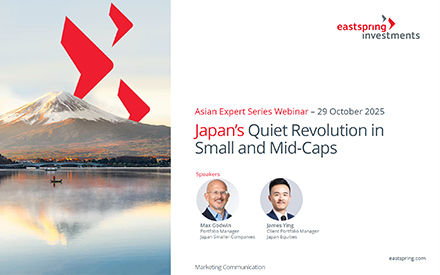Summary
China’s increasing dominance within the emerging markets investable universe has numerous implications for strategic asset allocation and for allocators seeking to diversify sources of alpha across return-seeking assets. Despite heightened geopolitical risks and volatility, China plays a critical role within global portfolios and within EM equity allocations. The decision of whether asset owners want to invest in China and how to go about doing so is a complex and subjective topic but deserving of serious consideration.
As a specialist manager in Asia, with a long history of investing and operating in China, Eastspring believes that for many allocators the longer-term financial case for adding exposure to China is quite compelling. While this comes with headline risks given deteriorating relations with the West, the tremendous alpha opportunity is hard to ignore. As China’s influence and size within EM indices grows, we believe it may be more efficient to gain exposure through a dedicated China allocation while at the same time, creating a separate and less correlated EM ex China allocation. While still early days, there’ve been increased discussions among large public and sovereign wealth funds about making the shift and numerous managers have launched ex-China strategies to meet anticipated demand. In some cases, the decision to exclude China all together is based on opposing views of risks or given ESG concerns, in which case an ex-China allocation is also an effective solution.
While strategic asset allocation decisions have implications for China’s domestic markets, they also create “spill-over” effects on peripheral EM countries outside China, which stand to benefit from shifting allocations within an ex- China framework. Coupled with positive foreign direct investments (FDI) into peripheral EM countries resulting from diversification of global supply chains, the “China +1 effect” is creating substantive positive tailwinds for ex-China beneficiaries. With China comprising 30% of the MSCI EM index and continuing to grow, it’s arguable that it’s still under-represented within global portfolios, justifying larger, discrete allocations. China represented 5% of the MSCI EM Index 20 years ago, and at year end 2022, it stood at 32% and is forecast to hit 44% with 100% inclusion of onshore China A shares. As China’s index weighting continues to rise, attractive alpha opportunities in other emerging markets will continue to be crowded out as they have disproportionately smaller index weights. Asset owners cannot afford to miss out on idiosyncratic opportunities across EMs ex China and shouldn’t have their opportunity set limited by the benchmark.
As historically seen with ACWI ex U.S. and Asia Pacific ex Japan, when a single country dominates a global or regional index, sophisticated investors typically transition to discrete allocations to that dominant market to better optimize active risks and in turn often hire specialized asset managers within that region to generate alpha. This transformation to EM ex-China plus dedicated China is gaining traction and we believe it’s the beginning of a sustained, longer-term shift in strategic asset allocations.
Sources:
1Eastspring Investments, 31 January 2023. MSCI Index.
The information and views expressed herein do not constitute an offer or solicitation to deal in shares of any securities or financial instruments and it is not intended for distribution or use by anyone or entity located in any jurisdiction where such distribution would be unlawful or prohibited. The information does not constitute investment advice or an offer to provide investment advisory or investment management service or the solicitation of an offer to provide investment advisory or investment management services in any jurisdiction in which an offer or solicitation would be unlawful under the securities laws of that jurisdiction.
Past performance and the predictions, projections, or forecasts on the economy, securities markets or the economic trends of the markets are not necessarily indicative of the future or likely performance of Eastspring Investments or any of the strategies managed by Eastspring Investments. An investment is subject to investment risks, including the possible loss of the principal amount invested. Where an investment is denominated in another currency, exchange rates may have an adverse effect on the value price or income of that investment. Furthermore, exposure to a single country market, specific portfolio composition or management techniques may potentially increase volatility.
Any securities mentioned are included for illustration purposes only. It should not be considered a recommendation to purchase or sell such securities. There is no assurance that any security discussed herein will remain in the portfolio at the time you receive this document or that security sold has not been repurchased.
The information provided herein is believed to be reliable at time of publication and based on matters as they exist as of the date of preparation of this report and not as of any future date. Eastspring Investments undertakes no (and disclaims any) obligation to update, modify or amend this document or to otherwise notify you in the event that any matter stated in the materials, or any opinion, projection, forecast or estimate set forth in the document, changes or subsequently becomes inaccurate. Eastspring Investments personnel may develop views and opinions that are not stated in the materials or that are contrary to the views and opinions stated in the materials at any time and from time to time as the result of a negative factor that comes to its attention in respect to an investment or for any other reason or for no reason. Eastspring Investments shall not and shall have no duty to notify you of any such views and opinions. This document is solely for information and does not have any regard to the specific investment objectives, financial or tax situation and the particular needs of any specific person who may receive this document.
Eastspring Investments Inc. (Eastspring US) primary activity is to provide certain marketing, sales servicing, and client support in the US on behalf of Eastspring Investment (Singapore) Limited (“Eastspring Singapore”). Eastspring Singapore is an affiliated investment management entity that is domiciled and registered under, among other regulatory bodies, the Monetary Authority of Singapore (MAS). Eastspring Singapore and Eastspring US are both registered with the US Securities and Exchange Commission as a registered investment adviser. Registration as an adviser does not imply a level of skill or training. Eastspring US seeks to identify and introduce to Eastspring Singapore potential institutional client prospects. Such prospects, once introduced, would contract directly with Eastspring Singapore for any investment management or advisory services. Additional information about Eastspring Singapore and Eastspring US is also is available on the SEC’s website at www.adviserinfo.sec. gov.
Certain information contained herein constitutes "forward-looking statements", which can be identified by the use of forward-looking terminology such as "may", "will", "should", "expect", "anticipate", "project", "estimate", "intend", "continue" or "believe" or the negatives thereof, other variations thereof or comparable terminology. Such information is based on expectations, estimates and projections (and assumptions underlying such information) and cannot be relied upon as a guarantee of future performance. Due to various risks and uncertainties, actual events or results, or the actual performance of any fund may differ materially from those reflected or contemplated in such forward-looking statements.
Eastspring Investments companies (excluding JV companies) are ultimately wholly-owned / indirect subsidiaries / associate of Prudential plc of the United Kingdom. Eastspring Investments companies (including JV’s) and Prudential plc are not affiliated in any manner with Prudential Financial, Inc., a company whose principal place of business is in the United States of America.














